
* While the army Lynx variants were only moderately successful, the naval Lynx variants achieved considerable export sales. Overall, the Lynx family has proven enduring, being updated in the 21st century to remain current.
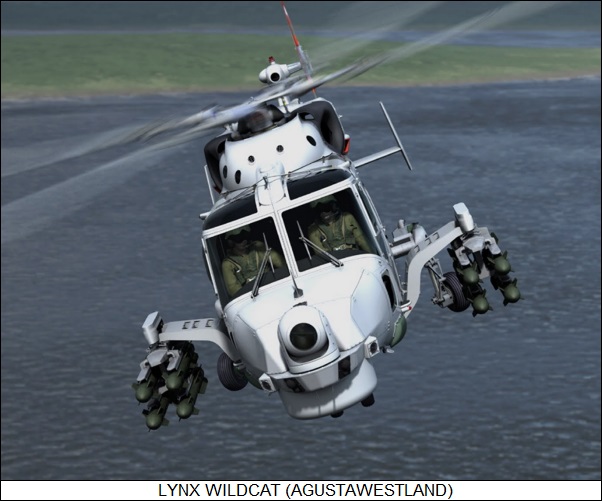
* As the Lynx was being developed, the Royal Navy had a strong interest in the type, and so a navalized Lynx was designed in parallel with the Army Lynx. The Royal Navy found the Wasp inadequate and had an immediate need for a more effective replacement, so development of the naval Lynx was given priority.
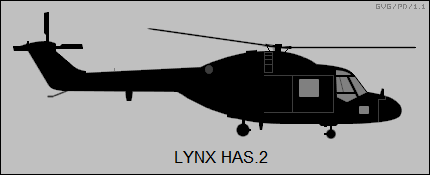
First flight of the initial Royal Navy production "Lynx HAS.2" was on 10 February 1976, with the type entering formal service in early 1981. The Lynx HAS.2 featured the twin Gem 2 powerplants of the British Army Lynx HAS.1, but differed in having:
Crew was typically three, including pilot, copilot, and sensor operator or loadmaster.
A total of 60 Lynx HAS.2 machines was obtained by the Royal Navy, the type being used in transport, scout, and maritime combat roles. It could carry twin Mark 44/46 or Stingray homing torpedoes; twin Mark 11 depth charges; or four Sea Skua antiship missiles. In service, most HAS.2s were upgraded with provisions for carrying a towed "magnetic anomaly detector (MAD)" antisubmarine sensor, and a Decca MIR-2 Orange Crop "electronic support measures (ESM)" system to locate and target radar / radio emitters.
___________________________________________________________________
WESTLAND LYNX HAS.2:
___________________________________________________________________
main rotor diameter:
12.8 meters (42 feet)
tail rotor diameter:
2.21 meters (7 feet 3 inches)
fuselage length:
11.92 meters (39 feet 1 inch)
footprint length:
15.16 meters (49 feet 9 inches)
height (tail rotor):
3.60 meters (11 feet 10 inches)
height (rotor head):
2.96 meters (9 feet 9 inches)
empty weight:
3,345 kilograms (7,370 pounds)
max loaded weight:
4,765 kilograms (10,500 pounds)
maximum speed:
230 KPH (145 MPH / 125 KT)
hover ceiling:
2,575 meters (8,450 feet)
combat radius:
95 kilometers (60 MI / 50 NMI)
___________________________________________________________________
24 Lynx HAS.2s were used by the Royal Navy during Operation CORPORATE, the 1982 effort to reclaim the Falkland Islands from Argentina. Three were lost when the ships carrying them -- ARDENT, ATLANTIC CONVEYOR, and COVENTRY -- were sunk, and one on the HMS BROADSWORD lost its nose when a dud bomb passed through the helicopter deck. There were no losses in direct combat -- though one Lynx pilot had to do some fancy flying to dodge the attacks of two Argentine Dagger / Mirage fighters -- or from accidents during the operation.
The Lynxes also showed their claws. On 2 April 1982, two Lynxes attacked the Argentine submarine SANTA FE as it tried to leave Grytviken harbor on South Georgia, an island well to the east of the Falklands that the Argentines had also occupied. One Lynx dropped a homing torpedo, which continued to cruise around under the submarine, waiting for it to dive; the submarine's skipper decided not to and returned to harbor, where the vessel was worked over by the Lynxes with their machine guns, then disabled by Wasps firing AS-12 missiles.
On the night of 3 May, a Lynx operating in foul weather hit the Argentine patrol boat ALFEREZ SORBAL with four Sea Skuas. The boat wasn't sunk, but it was definitely no longer a threat. The Sea Skua hadn't actually been completely qualified for service at the time, but it had been rushed into combat. A Lynx scored two hits with Sea Skuas on the Argentine supply ship RIO CARACANA on 23 May, which had been previously damaged by British Harrier jump-jets, and finally decided to sink; while a Sea Skua damaged the patrol boat RIO IGUAXU on 13 June.
* There were a number of export variants of the Lynx HAS.2:
* After acquiring the HAS.2, the British Royal Navy obtained a modest upgrade, the "Lynx HAS.3", the main feature of which was Gem 42-1 Mark 204 engines with 836 kW (1,120 SHP) -- much the same as the Gem 4 Mark 1010 engines fitted to some export HAS.2 variants -- plus the three-pinion gearbox to handle the greater power. It also featured a new four-bag flotation system, with the Orange Crop ESM and MAD provided from the outset.
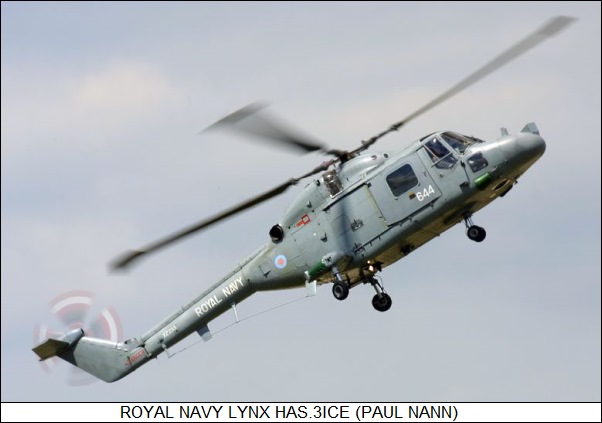
A total of 23 new-build Lynx HAS.3 machines was obtained by the Royal Navy from 1982 into 1985. 54 surviving HAS.2 machines were upgraded to Lynx HAS.3 standard as well. The fleet was eventually further upgraded to Gem 204/5 engines providing 835 kW (1,120 SHP) each, and received a number of other upgrades as well:
All variants in the HAS.3 fleet were eventually fitted with GEC Marconi AD3400 secure voice radios, with the designations updated to "HAS.3S", "HAS.3SGM", and "HAS.3SICE" accordingly. Export users of the HAS.3 included:
* In parallel with the dead-end Army Lynx 3, Westland mocked up a corresponding "Naval Lynx 3" with the same fat tailboom, tailfins, and other airframe changes, plus an undernose drum radome for 360-degree radar and a FLIR turret on top of the nose. Nobody bit on the Navy Lynx 3 either, but some of its advanced features would be used in the third-generation naval Lynx, the Royal Navy "Lynx HMA.8" and its export "Super Lynx" equivalents.
Seven Lynx HAS.3S machines were modified from 1989 for evaluation of new gear; these evaluation machines in particular featured the RAMS 4000 Central Tactical System, which integrated the Lynx's combat avionics systems and a datalink system to provide unified displays and system controls. These machines were redesignated "Lynx HAS.3CTS".
The HAS.3CTS effort led to the Lynx HMA.8, with three of the HAS.3CTS machines specifically used for trials of HMA.8 systems. The Lynx HMA.8 was something of a parallel upgrade to the Army Lynx AH.7, featuring Gem 42 Series 200 engines with 686 kW (920 SHP), BERP rotor blades, and the wider, reversed-rotating composite tail rotor. Externally, the HMA.8 featured an undernose drum radome for Seaspray Mark 3 360-degree radar, though due to economy measures the older 180-degree Seaspray Mark 1 was retained, fitted in the undernose radome; and a Sea Owl electro-optical "Passive Identification Device (PID)" fitted onto a turret in the nose. Other improvements include the RAMS 4000 CTS system evaluated on the Lynx HAS.3CTS machines; plus other new avionics, such as a GPS navigation receiver; and the four-bag flotation gear that was retrofitted to some Lynx HAS.3 machines.
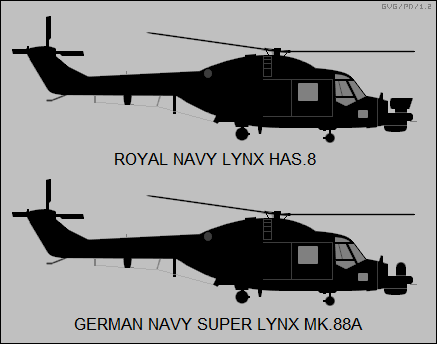
All production HMA.8 machines were conversions, with the three prototypes brought up to operational spec and at least 48 conversions of other Royal Navy HAS.3-type machines. Introduction of the HMA.8 to service was in 1992. Once in line service, the HMA.3 was upgraded with a new bolted rotor head, and the Seaspray Mark 1 radar was given digital signal processing capabilities (DSP); the machines with the upgraded radar were redesignated "HMA.8DSP" or "HMA.8(DP)". The HMA.8 machines were finally withdrawn in the spring of 2017, after a quarter-century of service.
* The specific fit of the Super Lynx export variants varied from customer to customer, the only common elements being the four-bag flotation system and the undernose radome -- though different radars could be fitted. Gem 42 engines were fitted initially, with the BERP main rotor, composite tail rotor, and a nose imager turret optional. Of course, avionics were customer-specific, with general provisions for different kinds of dipping sonar. New weapons options were also offered, with the ability to carry the Norwegian Kongsberg Penguin antiship missile as an alternative to the Sea Skua, as well as either US Stinger or French Mistral AAMs.
Later in the 1990s, Westland came up with the "Super Lynx Mark 200", which exchanged the Gem engines with LHTEC CTS800 turboshafts -- the CTS800 is the commercial equivalent of the T800 evaluated on the Lynx earlier -- and then the "Super Lynx Mark 300", with both the CTS800 engines plus a full glass cockpit and modernized avionics system, derived from the Agusta-Westland EH101 helicopter. Other options were available, such as a wire-cutter system.
Sales of the Super Lynx on the export market were no disappointment:
Incidentally, in 2000 Westland and the Italian Agusta helicopter company merged, and so the Lynx was then properly referred to as the "AgustaWestland" Lynx, AgustaWestland being a component of the Finmeccanica group. In 2016, that became the Leonardo group, and the Lynx becoming the "Leonardo" Lynx.
* The Lynx proved a valuable asset in British service, and an improved Lynx, originally known as the "Future Lynx" but later designated the "AW159 Lynx Wildcat", or just "Wildcat", has been acquired by the British Army and Royal Navy. The program went back and forth for a few years, but in 2008 the UK government committed to production. 62 machines were acquired, including 34 "Battlefield Reconnaissance Helicopters (BRH)" going to the British Army and 28 "Surface Combatant Marine Rotorcraft (SCMR)" to the Royal Navy. First flight of a Wildcat was in November 2009, with two more machines joining the flight-test program in 2010. It entered service in 2014.
As introduced, the Wildcat was fitted with the LHTEC CTS800-4N turboshaft, driving a reinforced transmission system, with the machine's payload raised to 2,056 kilograms (4,533 pounds), 20% more than the Lynx AH.9. Some airframe improvements were also implemented, most prominently Westland 30-style tailfins and a new tail rotor. Other improvements included a digital glass cockpit with four large multifunction displays (MFDs); an advanced countermeasures suite; improved IFF and data modem; and a nose-mounted electro-optical sensor turret, with laser target designator. The Wildcat had self-sealing fuel tanks, and an option for external tanks.
The Army Wildcat BRH was optimized for battlefield scouting and not for offensive combat, though it could carry cannon and unguided rocket pods, with aiming by a helmet-mounted sight system. The Royal Navy Wildcat SCMR was fitted with the Selex Galileo Seaspray 7000E 360-degree search radar, featuring a rotating active array radar. It was also equipped with a nose turret with imagers and target designator.
Armament included homing torpedoes, Hellfire, and the Thales "Lightweight Multirole Missile (LMM)" AKA "Martlet" -- a laser beam-riding missile with a launch weight of only 13 kilograms (28 pounds) and a range of 8 kilometers (5 miles), capable of dealing with either surface or air threats. It could also carry the replacement for the Sea Skua, the MBDA "Sea Venom" AKA "Anti-Navire Legere (ANL / anti-ship light)" antiship missile. There have also been experiments with using the Wildcat to control drones.
In 2018, Leonardo unveiled a new "weapons carriage wing" for the AW159 -- a stub wing, made of aluminum alloy and carbon composite, evolved from and intended to replace the traditional stores pylon scheme, the wing providing more flexibility in armament carriage. It could carry 20 Thales Martlet or four Sea Venom missiles, or ten Martlets and two Sea Venoms.
* 22 of the British Army's 22 Lynx AH.9 machines were upgraded with the CTS800-4N, being given the new designation of "AH.9A". The upgrade was on a fast-track basis to provide combat rotorcraft for "hot and high" service, clearly with an eye towards Afghanistan. Initial flight of the first AH.9A was in the late summer of 2009, with all 22 delivered by the end of 2011. The last of them were retired in favor of the Wildcat BRH in early 2018.
The first export order for the Wildcat was signed in early 2013, with the South Korean Navy obtaining eight for ASW, surface warfare roles, surveillance, and SAR. They had dipping sonar and were armed with anti-ship missiles -- including the Thales Lightweight Multirole Missile for engaging small craft, and a larger missile currently in development -- plus torpedoes and a door-mounted machine gun. Deliveries were in 2015:2017. Two ASW Wildcats were obtained by the Philippines in 2018, with delivery in 2019.
BACK_TO_TOP* One of the interesting sidebars to the Lynx story was that Westland designed a larger transport helicopter, the "Westland 30", based on the Lynx dynamic system but with a large-volume fuselage only loosely related to the original Lynx. The initial prototype made its first flight on 10 April 1979, leading to the first flight of the initial production machine in September 1981.
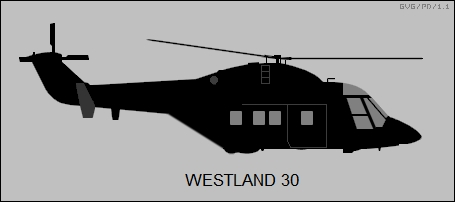
The Westland 30 was intended as a commercial or military transport. In civil form, it could carry up to 22 passengers in a high-density configuration. In its "TT.30" military form, it could accommodate 14 equipped troops, 17 unequipped troops, or six litters with medical attendants. The initial "Series 100" variant was powered by twin Rolls-Royce Gem 4 turboshafts providing 845 kW (1,120 SHP) each; it was followed by the "Series 100-60", with Gem 6 engines providing 940 kW (1,260 SHP) each. Along with the twin engines, the Westland 30 also had wider main and tail rotors, as well as retractable landing gear, with twin wheeled nose gear and single wheeled main gear. A single passenger door with an "airstair" was used for the passenger compartment, though the Westland 30 could also be ordered with sliding doors on both sides; as with the Lynx, the Westland 30 had cockpit side doors.
___________________________________________________________________
WESTLAND 30 SERIES 100-60:
___________________________________________________________________
main rotor diameter:
13.3 meters (43 feet 8 inches)
tail rotor diameter:
2.44 meters (8 feet)
footprint length:
15.91 meters (52 feet 2 inches)
height (tail rotor):
4.74 meters (15 feet 6 inches)
empty weight:
3,790 kilograms (8,355 pounds)
MTO weight:
5,600 kilograms (12,530 pounds)
maximum cruise speed:
220 KPH (135 MPH / 120 KT)
service ceiling:
790 meters (2,600 feet)
range:
350 kilometers (220 MI / 190 NMI)
___________________________________________________________________
The Series 100-60 was followed by improved Series 200 and Series 300 variants, with various enhancements such as more powerful engines, but the Westland 30 did not take the world by storm. Only small numbers were sold to civil operators, such as British Airways, and there were no sales to military forces. The Westland 30's lack of success appears to have been a contributing factor to a major financial crisis at Westland, which would lead to a political crisis and, ultimately, to the formation of AgustaWestland.
BACK_TO_TOP* There were a number of unbuilt variants of the Lynx. The original WG.13 specification that created the Lynx also included a concept for an optimized two-man helicopter gunship, with a slender fuselage, retractable landing gear, and a turret under the nose. It was intended mainly for the French Army, with an eye towards the armed scout role, but it never went beyond the paper stage, the French obtaining armed Gazelles for the battlefield scout mission instead.
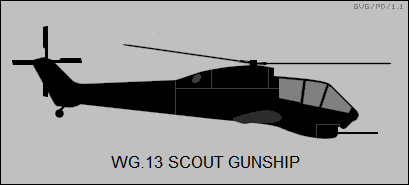
The Westland 30 civil transport helicopter derivative of the Lynx had been anticipated to an extent by an earlier concept, the Westland "Model 606", which was a Lynx with a fuselage stretch to accommodate up to 13 passengers, and uprated engines to handle the greater take-off weight. One of the Lynx prototypes was hacked up to serve as a nonflying mockup of the Model 606 and displayed at the Farnborough Air Show in 1972, but nobody bit on the idea, and no flight prototype was ever built.
The British Army considered a training version of the Lynx AH.1 designated the "Lynx HT.1", but it was too big for introductory training and not big enough for heavy helicopter training. The Gazelle was acquired for introductory training and the Westland Wessex used for heavy helicopter training.
* Helicopters are always dodgy to write up, because relatively few people care about them and reliable details are hard to find. Trying to determine production quantities, particularly of obscure types like the SARO Skeeter, is a real pain, and the Skeeter / Scout / Wasp production quantities given here are not much more than semi-educated guesswork.
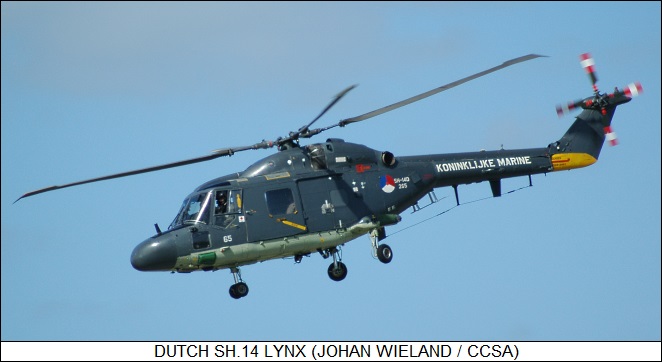
* Sources include:
The AgustaWestland website also had useful information on current Lynx sales deals.
* Revision history:
v1.0.0 / 01 oct 05 v1.0.1 / 01 sep 07 / Review & polish. v1.0.2 / 01 jan 09 / Review & polish. v1.1.0 / 01 jan 10 / Minor fixes, went to two chapters. v1.1.1 / 01 jan 12 / Review & polish. v1.1.2 / 01 dec 13 / Review & polish. v1.1.3 / 01 nov 15 / Review & polish. v1.1.4 / 01 oct 17 / Review & polish. v1.1.5 / 01 sep 19 / Review, update, & polish. v1.1.6 / 01 aug 21 / Review, update, & polish. v1.1.7 / 01 jul 23 / Review & polish. v1.1.8 / 01 jul 25 / Review & polish. (*)BACK_TO_TOP
